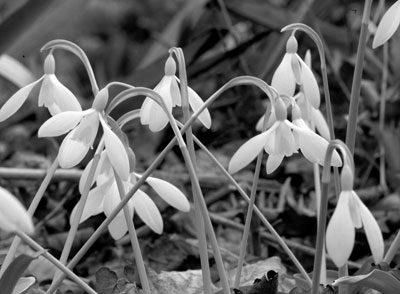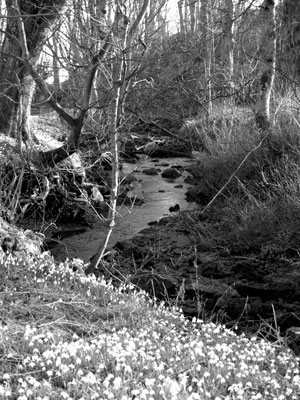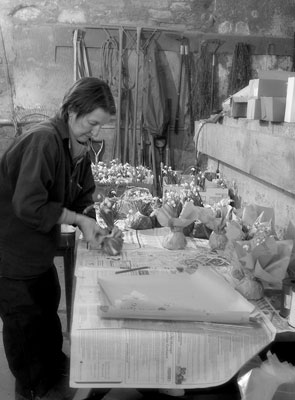Galloping galanthophiles! It’s snowdrop time in Scotland
This item appears on page 78 of the January 2009 issue.
by Yvonne Horn
“Take the path to the sea,” the man in the blue, woolly sweater advised. “It’s quite a lovely walk.”
“Are you the head gardener?” I asked.
“No,” he responded with a smile. “I’m Peter Erskine.”
“Oh!,” I said, as it dawned on me that the blue, woolly sweater wearer was Sir Peter Erskine, heir to this estate to which I’d come to spend a day wandering its acres swathed in snowdrops. Cambo Estate, one of Scotland’s grandest.
Beginning in late December through March, hundreds, even thousands, of visitors pour through Cambo’s entrance gates to “ooh” and “aah” over sweeping swaths of tiny, white ballerina skirts nodding beneath winter-bare beech, oak and sycamore woodlands. Most arrive between Feb. 1 (when I visited in 2008) and mid-March, beckoned by the Scottish Snowdrop Festival & Trail, an annual celebration that draws “galanthophiles,” or snowdrop enthusiasts, from the world over.
In 2008, 53 of Scotland’s estates and gardens threw open their doors in celebration of the snowdrop. Of them, Cambo, on the edge of the North Sea but seven miles south of St. Andrews, promises the most extravagant and diverse snowdrop display.
Snowdrops arrive
Snowdrops, or Galanthus (from the Greek gala, meaning “milk,” and anthos, “flower”), have claimed the hearts of the British for centuries, signaling as they pierce through the cold earth that the gray skies of winter will indeed depart and that spring is around the corner.
So prolific are Britain’s snowdrops, showing up everywhere from cemeteries to ditches to grand estates, that an easy assumption is they are native.
Not so, although their origin remains a mystery. One belief, since they are frequently found in the gardens of old monasteries, is that monks arriving from Italy in the 15th century brought bulbs with them. Lending credence to that belief is that Britain’s first garden reference to snowdrops appears in the 1597-published “General Historie of Plants” by English herbalist John Gerard.
No records exist at Cambo Estate, where the Erskine family has lived since the 17th century, as to when snowdrops were introduced. Peter Erskine, however, credits his grandmother, Magdalene, with encouraging their spread throughout its 70 acres of woodlands. An avid gardener, she “dragooned,” as Peter describes it, her eight children into helping her dig, divide and replant dormant bulbs.
Lady Erskine’s collection
It is the current Lady Erskine, however, Peter’s wife, Catherine, who has put Cambo on the snowdrop map as a must-see destination for galanthophiles and those just looking for lovely walks through the woods.
Catherine’s involvement began 30 years ago when Peter’s parents turned the estate over to the couple. A 2½-acre walled garden, gone into disrepair, captured her attention.
“I wanted to rescue the garden,” she said, “and I needed money for plants.”
For several years she sold autumn-dug snowdrop bulbs, charging so much a tray.
“Then I read that it was better to plant snowdrops straight after flowering,” she said.
A business of offering snowdrops “in the green” blossomed.
“The youngest of our five children was born in January and I was sending out bulbs in February and March. It was a bit crazy,” she remembered.
Eventually she enlisted the youngsters’ help.
“Unlike Peter’s grandmother, I paid them!” she added with a laugh.
The fame of Cambo snowdrops spread, along with Catherine’s growing awareness of the often-minute differences between varieties. The world’s galanthophiles have identified 19 species, a handful of natural hybrids and some 700 varieties.
Catherine’s specialty collection numbers more than 200 — “planted close to the house so I can keep an eye on them,” she said — painstakingly labeled and, in their raised beds, readily displaying delightful variations in shapes and markings.
In 2007 the National Council for the Conservation of Plants & Gardens officially recognized Lady Erskine’s collection.
The Snowdrop Fair
In recent years, demand for specialist bulbs has skyrocketed. While not approaching the binge of “tulipmania” that engulfed the Dutch in the 1630s, when tulip bulb prices rose out of all proportion to economic reality, a single specialist snowdrop bulb sold at auction last year in England for the equivalent of $200.
What began at Cambo as a way to refurbish the walled garden — now accomplished, with the garden a year-round visitor attraction — has turned into a business dispatching hundreds of thousands of bulbs. No longer is Catherine the sole worker. Six employees and a small army of volunteers give her a hand.
The snowdrop, a cottage industry — if that it could be called, given the size of Cambo’s manor house — metamorphosed into a full-scale business and tourist attraction. During February and March, Cambo promotes itself as a Snowdrop Fair. Plants (snowdrops, aconites, helleborus, cyclamen and crocus) are potted up for sale; a gift shop displays local potters’ snowdrop-inspired wares; artwork on the theme of snowdrops provides an art show, and a tearoom serves. Snowdrop talks and guided walks complete the program.
Other woodland owners jumped on Cambo’s snowdrop bandwagon with their versions of a fair.
“As interest increased throughout Scotland,” Catherine said, “it seemed sensible to bring all the owners of snowdrop woods and gardens together under one umbrella and promote a Snowdrop Festival & Trail throughout Scotland.”
The National Trust for Scotland and Scotland’s Gardens’ Scheme agreed, along with VisitScotland, the Scottish national tourist board. In 2006, the first nationwide festival was held, enticing some 7,500 visitors to tiptoe through the country’s snowdrops. A grateful VisitScotland recognized Sir Peter and Lady Erskine with a Scottish Thistle Award for excellence and innovation.
Those meeting Lady Erskine as she goes about her snowdrop tasks dressed in her everyday gear of work boots, scarf wound around her neck and sturdy gardener’s jacket might be excused for mistaking her for Cambo’s head gardener. If in doubt, just ask the man in the blue woolly sweater.
Cambo Estate and snowdrops
Cambo Estate (phone 01333 450313, fax 01333 450987, e-mail cambo@camboestate.com or visit www.camboestate.com) is situated on the A917 St. Andrews to Crail road, just south of the village of Kingsbarns. Singposted directions appear frequently. Entry costs £4 ($7.50).
Overnight accommodation is available at the estate. Rates vary with the size of the room or apartment, the time of year and the number of nights requested. Examples — a bed-and-breakfast guest room currently runs £47-£52 ($83-$90) per adult per night. For two nights (minimum), 2-person self-catering apartments cost £280-£470 ($484-$812) and 6-person apartments cost £500-£990.
Snowdrop Festival 2009 is scheduled for Feb. 1 to mid-March. For information, visit www.visitscotland.com/snowdrop-festival.




